Research Proposal: Health Literacy for Diabetes Management in India
VerifiedAdded on 2023/01/19
|25
|6022
|36
Report
AI Summary
This research proposal addresses the growing concern of diabetes in India, where over 69.2 million people are affected, with projections estimating a rise to 90 million by 2030. The proposal highlights the need for improved disease counseling and education programs to combat the increasing disease burden and poor patient outcomes. The research aims to implement an online education program to enhance health literacy and promote self-management strategies among Indian patients with diabetes. The proposal includes a literature review, methodology, research questions, and objectives, focusing on factors contributing to diabetes development, reasons for undiagnosed cases, and the potential of health literacy to improve patient outcomes. The expected outcome is to empower participants with self-management skills, improve their quality of life, and reduce medical costs through effective symptom monitoring and blood glucose level control. The research intends to disseminate awareness among the people about the disorder. It can be stated in this context that imparting awareness would help in empowering the people to adapt measures to manage the symptoms of the disease. In addition to this, it would also lead to a decrease in the number of cases that go unreported and would also reduce the medical expenditure related to the treatment of the disorder.
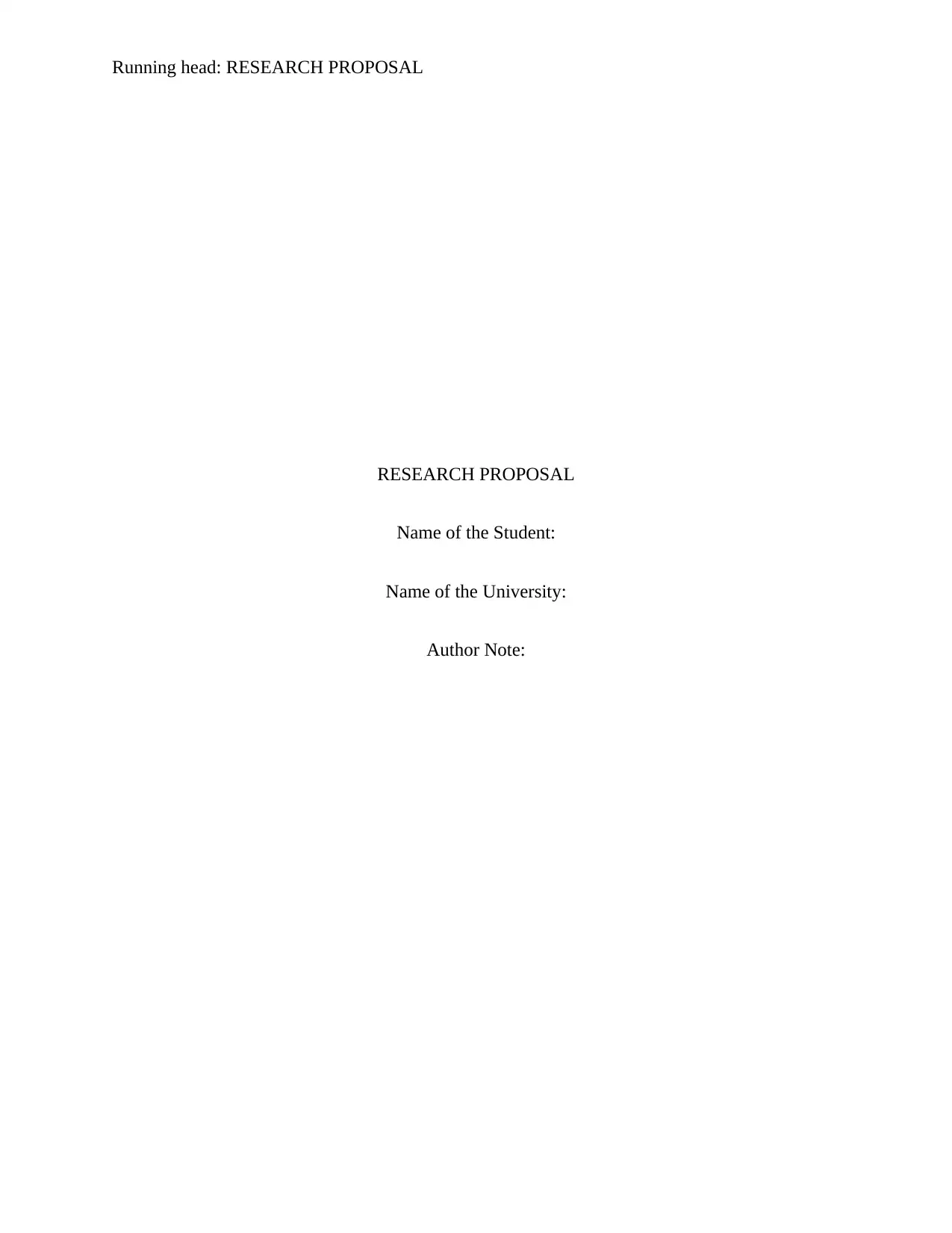
Running head: RESEARCH PROPOSAL
RESEARCH PROPOSAL
Name of the Student:
Name of the University:
Author Note:
RESEARCH PROPOSAL
Name of the Student:
Name of the University:
Author Note:
Paraphrase This Document
Need a fresh take? Get an instant paraphrase of this document with our AI Paraphraser
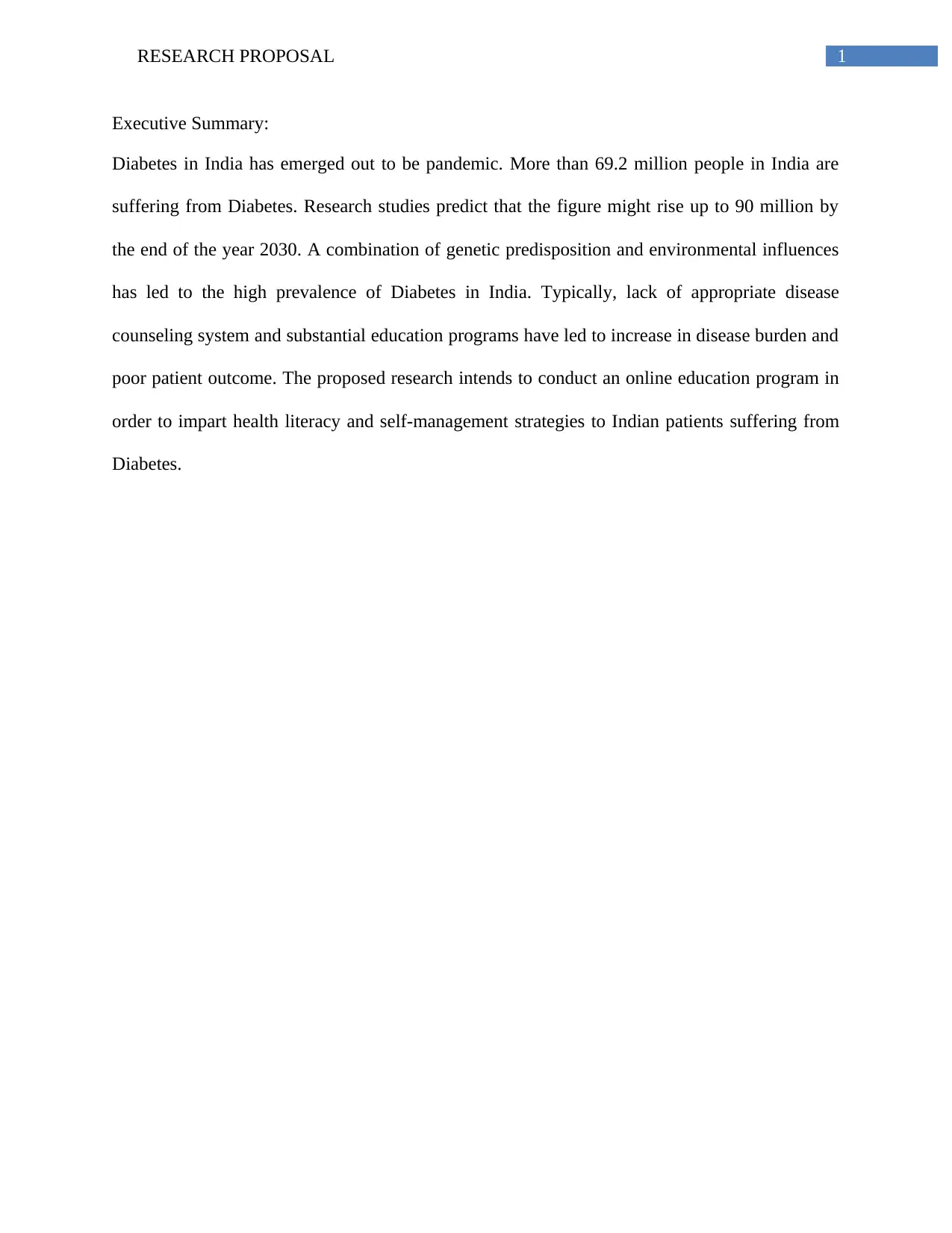
1RESEARCH PROPOSAL
Executive Summary:
Diabetes in India has emerged out to be pandemic. More than 69.2 million people in India are
suffering from Diabetes. Research studies predict that the figure might rise up to 90 million by
the end of the year 2030. A combination of genetic predisposition and environmental influences
has led to the high prevalence of Diabetes in India. Typically, lack of appropriate disease
counseling system and substantial education programs have led to increase in disease burden and
poor patient outcome. The proposed research intends to conduct an online education program in
order to impart health literacy and self-management strategies to Indian patients suffering from
Diabetes.
Executive Summary:
Diabetes in India has emerged out to be pandemic. More than 69.2 million people in India are
suffering from Diabetes. Research studies predict that the figure might rise up to 90 million by
the end of the year 2030. A combination of genetic predisposition and environmental influences
has led to the high prevalence of Diabetes in India. Typically, lack of appropriate disease
counseling system and substantial education programs have led to increase in disease burden and
poor patient outcome. The proposed research intends to conduct an online education program in
order to impart health literacy and self-management strategies to Indian patients suffering from
Diabetes.
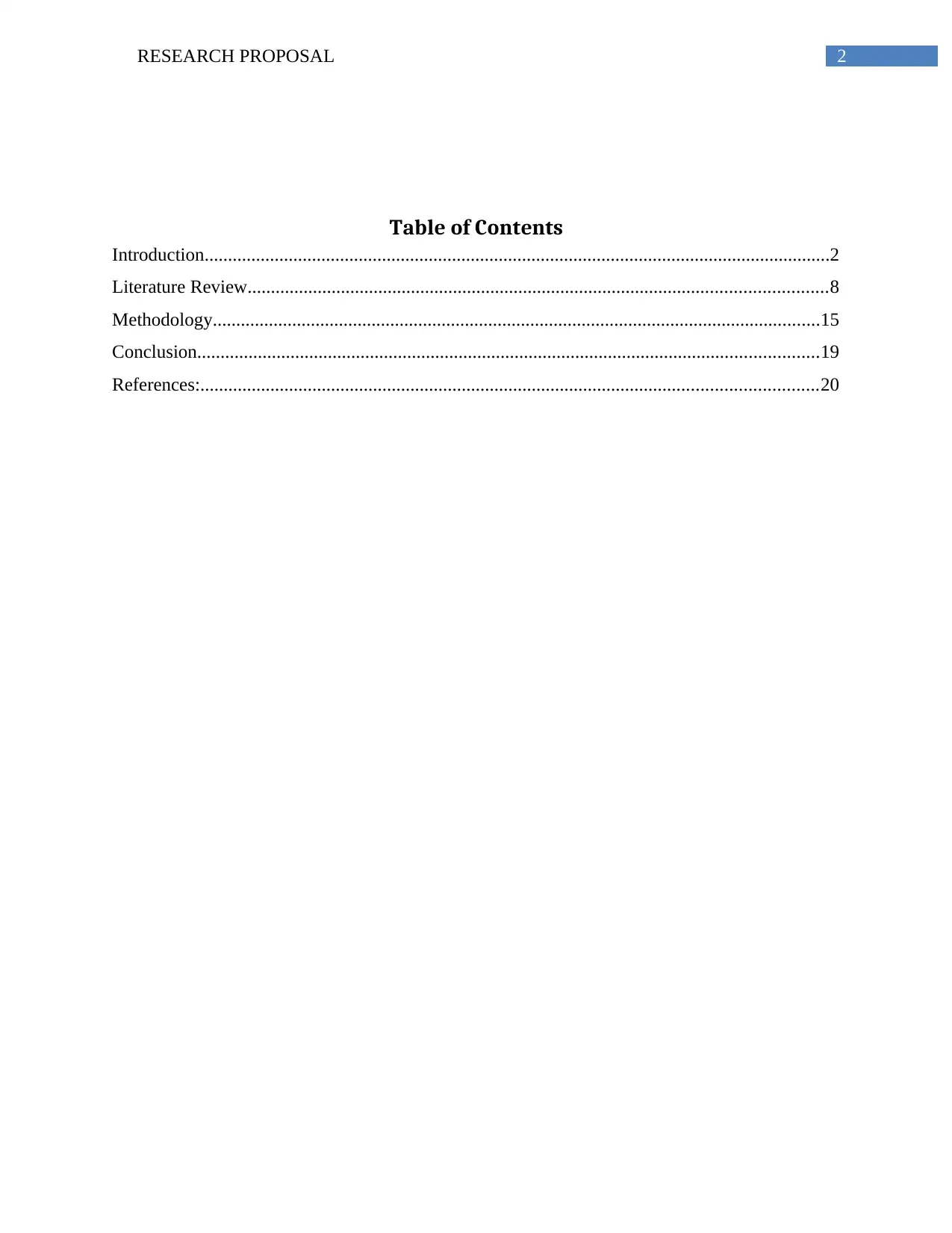
2RESEARCH PROPOSAL
Table of Contents
Introduction......................................................................................................................................2
Literature Review............................................................................................................................8
Methodology..................................................................................................................................15
Conclusion.....................................................................................................................................19
References:....................................................................................................................................20
Table of Contents
Introduction......................................................................................................................................2
Literature Review............................................................................................................................8
Methodology..................................................................................................................................15
Conclusion.....................................................................................................................................19
References:....................................................................................................................................20
⊘ This is a preview!⊘
Do you want full access?
Subscribe today to unlock all pages.

Trusted by 1+ million students worldwide
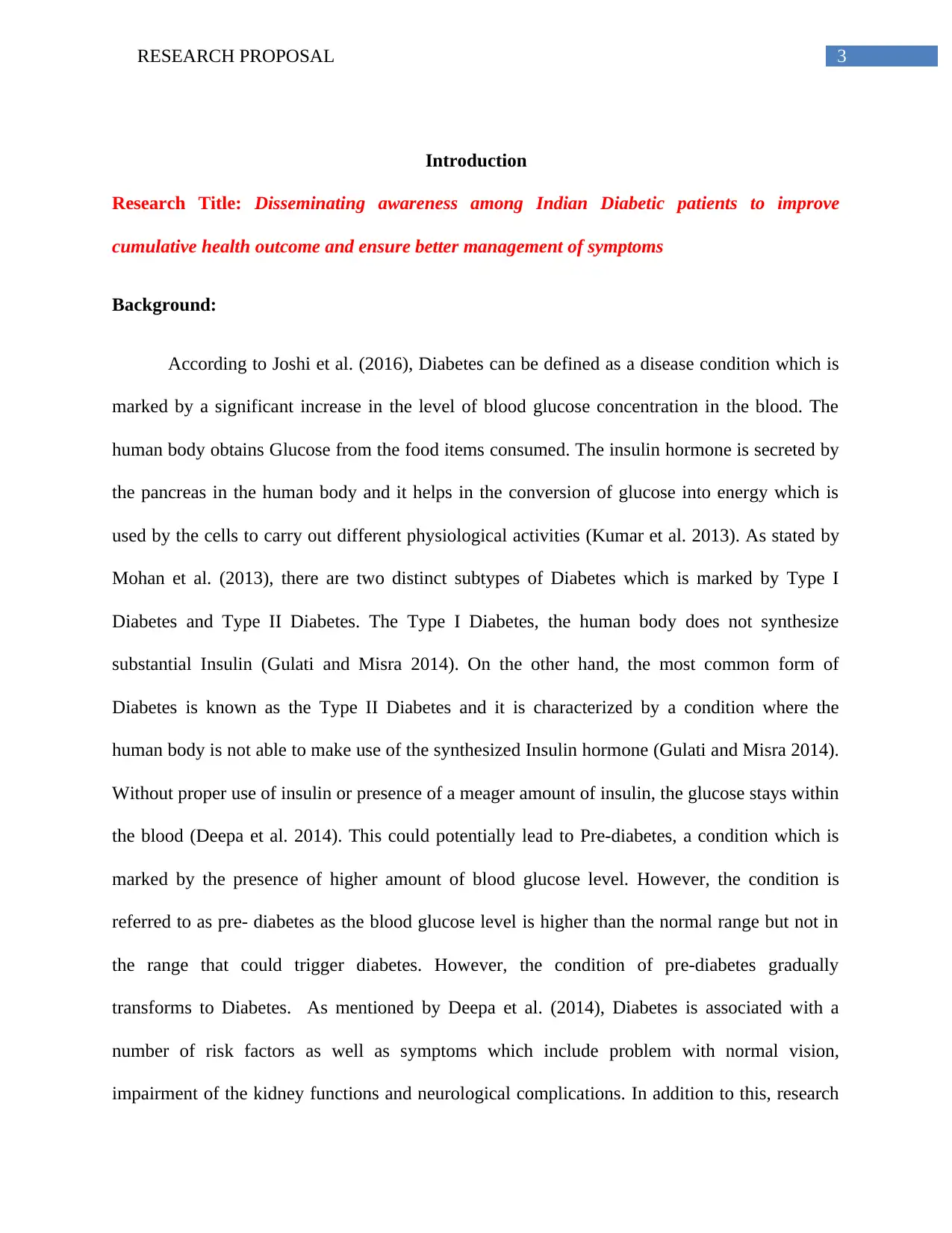
3RESEARCH PROPOSAL
Introduction
Research Title: Disseminating awareness among Indian Diabetic patients to improve
cumulative health outcome and ensure better management of symptoms
Background:
According to Joshi et al. (2016), Diabetes can be defined as a disease condition which is
marked by a significant increase in the level of blood glucose concentration in the blood. The
human body obtains Glucose from the food items consumed. The insulin hormone is secreted by
the pancreas in the human body and it helps in the conversion of glucose into energy which is
used by the cells to carry out different physiological activities (Kumar et al. 2013). As stated by
Mohan et al. (2013), there are two distinct subtypes of Diabetes which is marked by Type I
Diabetes and Type II Diabetes. The Type I Diabetes, the human body does not synthesize
substantial Insulin (Gulati and Misra 2014). On the other hand, the most common form of
Diabetes is known as the Type II Diabetes and it is characterized by a condition where the
human body is not able to make use of the synthesized Insulin hormone (Gulati and Misra 2014).
Without proper use of insulin or presence of a meager amount of insulin, the glucose stays within
the blood (Deepa et al. 2014). This could potentially lead to Pre-diabetes, a condition which is
marked by the presence of higher amount of blood glucose level. However, the condition is
referred to as pre- diabetes as the blood glucose level is higher than the normal range but not in
the range that could trigger diabetes. However, the condition of pre-diabetes gradually
transforms to Diabetes. As mentioned by Deepa et al. (2014), Diabetes is associated with a
number of risk factors as well as symptoms which include problem with normal vision,
impairment of the kidney functions and neurological complications. In addition to this, research
Introduction
Research Title: Disseminating awareness among Indian Diabetic patients to improve
cumulative health outcome and ensure better management of symptoms
Background:
According to Joshi et al. (2016), Diabetes can be defined as a disease condition which is
marked by a significant increase in the level of blood glucose concentration in the blood. The
human body obtains Glucose from the food items consumed. The insulin hormone is secreted by
the pancreas in the human body and it helps in the conversion of glucose into energy which is
used by the cells to carry out different physiological activities (Kumar et al. 2013). As stated by
Mohan et al. (2013), there are two distinct subtypes of Diabetes which is marked by Type I
Diabetes and Type II Diabetes. The Type I Diabetes, the human body does not synthesize
substantial Insulin (Gulati and Misra 2014). On the other hand, the most common form of
Diabetes is known as the Type II Diabetes and it is characterized by a condition where the
human body is not able to make use of the synthesized Insulin hormone (Gulati and Misra 2014).
Without proper use of insulin or presence of a meager amount of insulin, the glucose stays within
the blood (Deepa et al. 2014). This could potentially lead to Pre-diabetes, a condition which is
marked by the presence of higher amount of blood glucose level. However, the condition is
referred to as pre- diabetes as the blood glucose level is higher than the normal range but not in
the range that could trigger diabetes. However, the condition of pre-diabetes gradually
transforms to Diabetes. As mentioned by Deepa et al. (2014), Diabetes is associated with a
number of risk factors as well as symptoms which include problem with normal vision,
impairment of the kidney functions and neurological complications. In addition to this, research
Paraphrase This Document
Need a fresh take? Get an instant paraphrase of this document with our AI Paraphraser
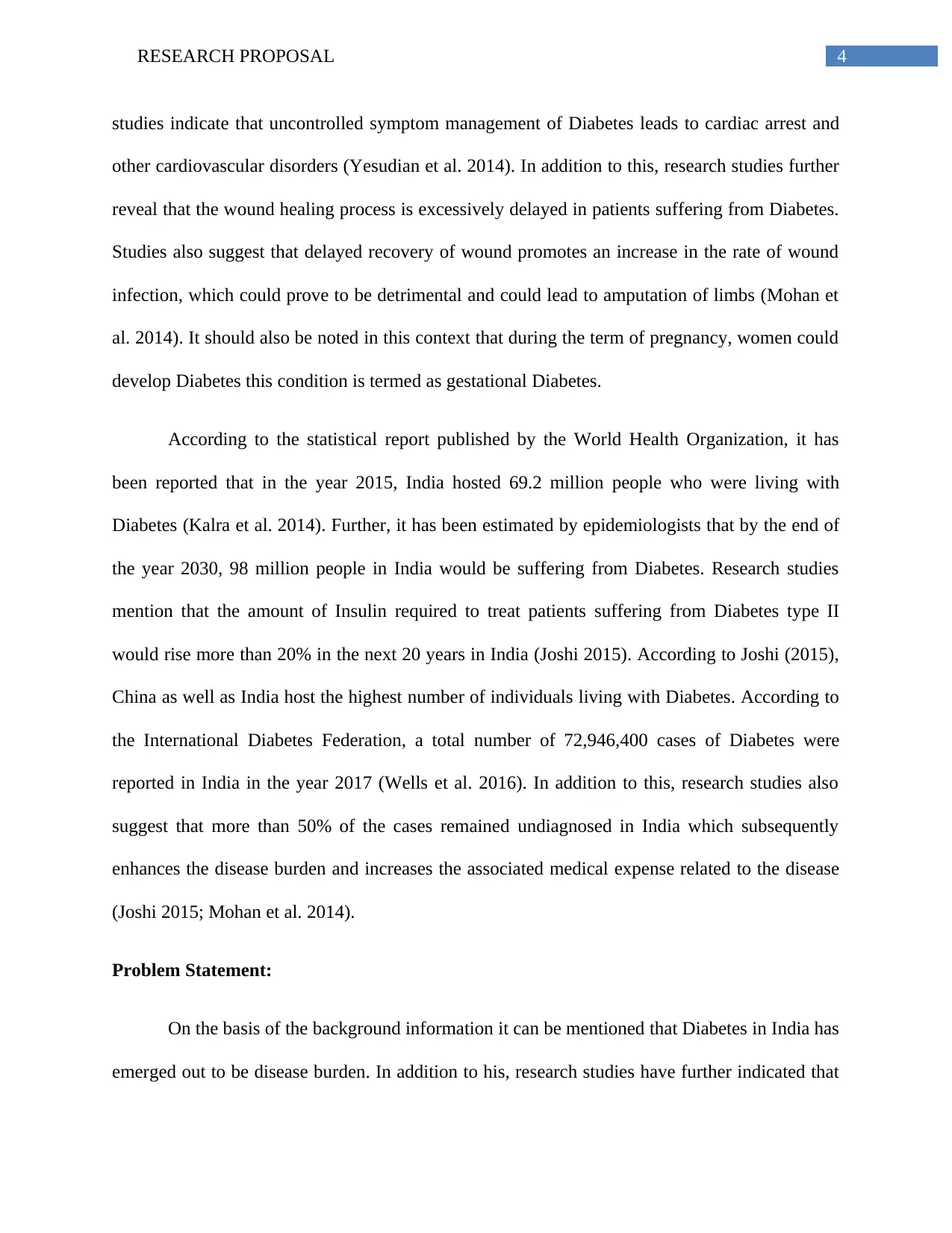
4RESEARCH PROPOSAL
studies indicate that uncontrolled symptom management of Diabetes leads to cardiac arrest and
other cardiovascular disorders (Yesudian et al. 2014). In addition to this, research studies further
reveal that the wound healing process is excessively delayed in patients suffering from Diabetes.
Studies also suggest that delayed recovery of wound promotes an increase in the rate of wound
infection, which could prove to be detrimental and could lead to amputation of limbs (Mohan et
al. 2014). It should also be noted in this context that during the term of pregnancy, women could
develop Diabetes this condition is termed as gestational Diabetes.
According to the statistical report published by the World Health Organization, it has
been reported that in the year 2015, India hosted 69.2 million people who were living with
Diabetes (Kalra et al. 2014). Further, it has been estimated by epidemiologists that by the end of
the year 2030, 98 million people in India would be suffering from Diabetes. Research studies
mention that the amount of Insulin required to treat patients suffering from Diabetes type II
would rise more than 20% in the next 20 years in India (Joshi 2015). According to Joshi (2015),
China as well as India host the highest number of individuals living with Diabetes. According to
the International Diabetes Federation, a total number of 72,946,400 cases of Diabetes were
reported in India in the year 2017 (Wells et al. 2016). In addition to this, research studies also
suggest that more than 50% of the cases remained undiagnosed in India which subsequently
enhances the disease burden and increases the associated medical expense related to the disease
(Joshi 2015; Mohan et al. 2014).
Problem Statement:
On the basis of the background information it can be mentioned that Diabetes in India has
emerged out to be disease burden. In addition to his, research studies have further indicated that
studies indicate that uncontrolled symptom management of Diabetes leads to cardiac arrest and
other cardiovascular disorders (Yesudian et al. 2014). In addition to this, research studies further
reveal that the wound healing process is excessively delayed in patients suffering from Diabetes.
Studies also suggest that delayed recovery of wound promotes an increase in the rate of wound
infection, which could prove to be detrimental and could lead to amputation of limbs (Mohan et
al. 2014). It should also be noted in this context that during the term of pregnancy, women could
develop Diabetes this condition is termed as gestational Diabetes.
According to the statistical report published by the World Health Organization, it has
been reported that in the year 2015, India hosted 69.2 million people who were living with
Diabetes (Kalra et al. 2014). Further, it has been estimated by epidemiologists that by the end of
the year 2030, 98 million people in India would be suffering from Diabetes. Research studies
mention that the amount of Insulin required to treat patients suffering from Diabetes type II
would rise more than 20% in the next 20 years in India (Joshi 2015). According to Joshi (2015),
China as well as India host the highest number of individuals living with Diabetes. According to
the International Diabetes Federation, a total number of 72,946,400 cases of Diabetes were
reported in India in the year 2017 (Wells et al. 2016). In addition to this, research studies also
suggest that more than 50% of the cases remained undiagnosed in India which subsequently
enhances the disease burden and increases the associated medical expense related to the disease
(Joshi 2015; Mohan et al. 2014).
Problem Statement:
On the basis of the background information it can be mentioned that Diabetes in India has
emerged out to be disease burden. In addition to his, research studies have further indicated that
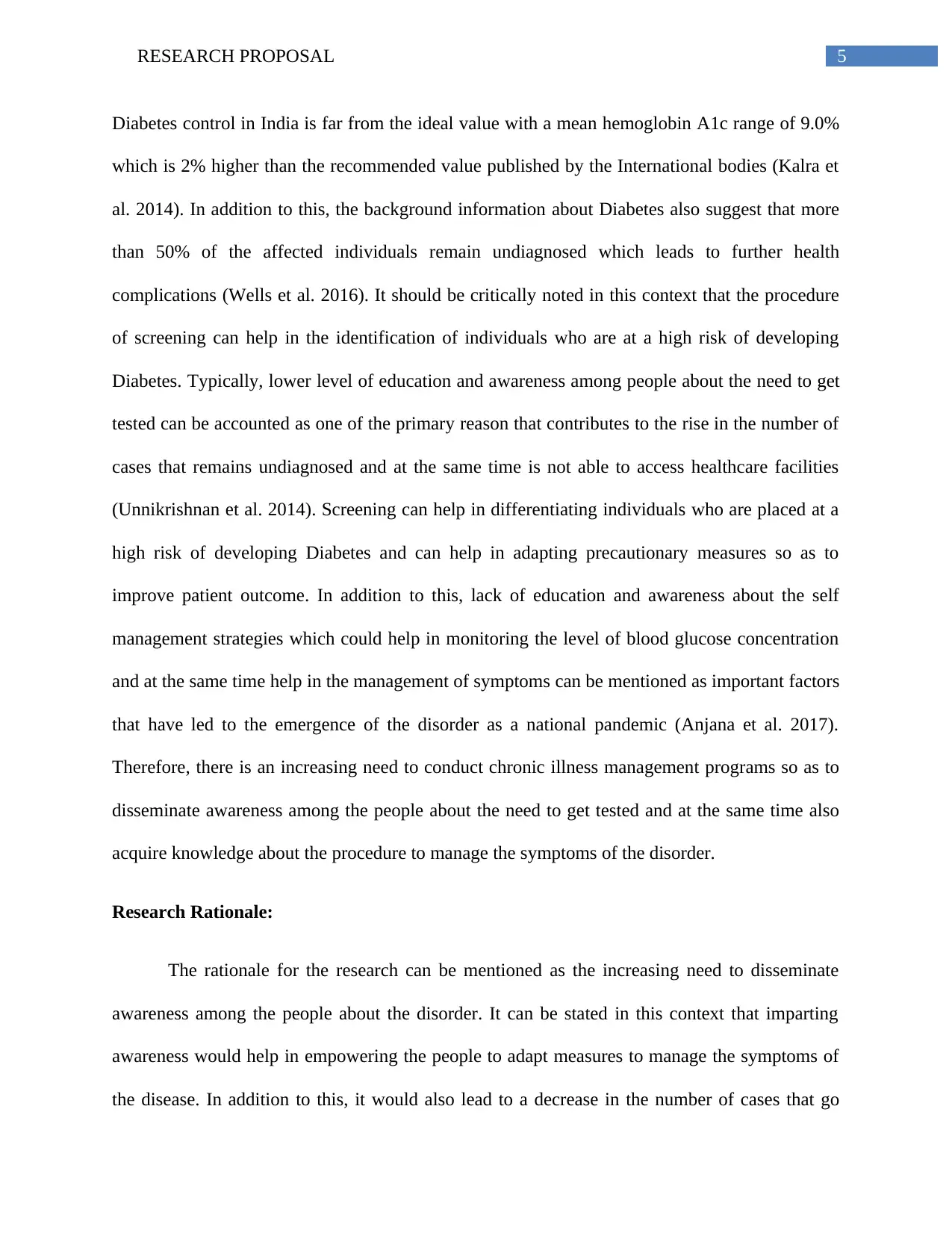
5RESEARCH PROPOSAL
Diabetes control in India is far from the ideal value with a mean hemoglobin A1c range of 9.0%
which is 2% higher than the recommended value published by the International bodies (Kalra et
al. 2014). In addition to this, the background information about Diabetes also suggest that more
than 50% of the affected individuals remain undiagnosed which leads to further health
complications (Wells et al. 2016). It should be critically noted in this context that the procedure
of screening can help in the identification of individuals who are at a high risk of developing
Diabetes. Typically, lower level of education and awareness among people about the need to get
tested can be accounted as one of the primary reason that contributes to the rise in the number of
cases that remains undiagnosed and at the same time is not able to access healthcare facilities
(Unnikrishnan et al. 2014). Screening can help in differentiating individuals who are placed at a
high risk of developing Diabetes and can help in adapting precautionary measures so as to
improve patient outcome. In addition to this, lack of education and awareness about the self
management strategies which could help in monitoring the level of blood glucose concentration
and at the same time help in the management of symptoms can be mentioned as important factors
that have led to the emergence of the disorder as a national pandemic (Anjana et al. 2017).
Therefore, there is an increasing need to conduct chronic illness management programs so as to
disseminate awareness among the people about the need to get tested and at the same time also
acquire knowledge about the procedure to manage the symptoms of the disorder.
Research Rationale:
The rationale for the research can be mentioned as the increasing need to disseminate
awareness among the people about the disorder. It can be stated in this context that imparting
awareness would help in empowering the people to adapt measures to manage the symptoms of
the disease. In addition to this, it would also lead to a decrease in the number of cases that go
Diabetes control in India is far from the ideal value with a mean hemoglobin A1c range of 9.0%
which is 2% higher than the recommended value published by the International bodies (Kalra et
al. 2014). In addition to this, the background information about Diabetes also suggest that more
than 50% of the affected individuals remain undiagnosed which leads to further health
complications (Wells et al. 2016). It should be critically noted in this context that the procedure
of screening can help in the identification of individuals who are at a high risk of developing
Diabetes. Typically, lower level of education and awareness among people about the need to get
tested can be accounted as one of the primary reason that contributes to the rise in the number of
cases that remains undiagnosed and at the same time is not able to access healthcare facilities
(Unnikrishnan et al. 2014). Screening can help in differentiating individuals who are placed at a
high risk of developing Diabetes and can help in adapting precautionary measures so as to
improve patient outcome. In addition to this, lack of education and awareness about the self
management strategies which could help in monitoring the level of blood glucose concentration
and at the same time help in the management of symptoms can be mentioned as important factors
that have led to the emergence of the disorder as a national pandemic (Anjana et al. 2017).
Therefore, there is an increasing need to conduct chronic illness management programs so as to
disseminate awareness among the people about the need to get tested and at the same time also
acquire knowledge about the procedure to manage the symptoms of the disorder.
Research Rationale:
The rationale for the research can be mentioned as the increasing need to disseminate
awareness among the people about the disorder. It can be stated in this context that imparting
awareness would help in empowering the people to adapt measures to manage the symptoms of
the disease. In addition to this, it would also lead to a decrease in the number of cases that go
⊘ This is a preview!⊘
Do you want full access?
Subscribe today to unlock all pages.

Trusted by 1+ million students worldwide
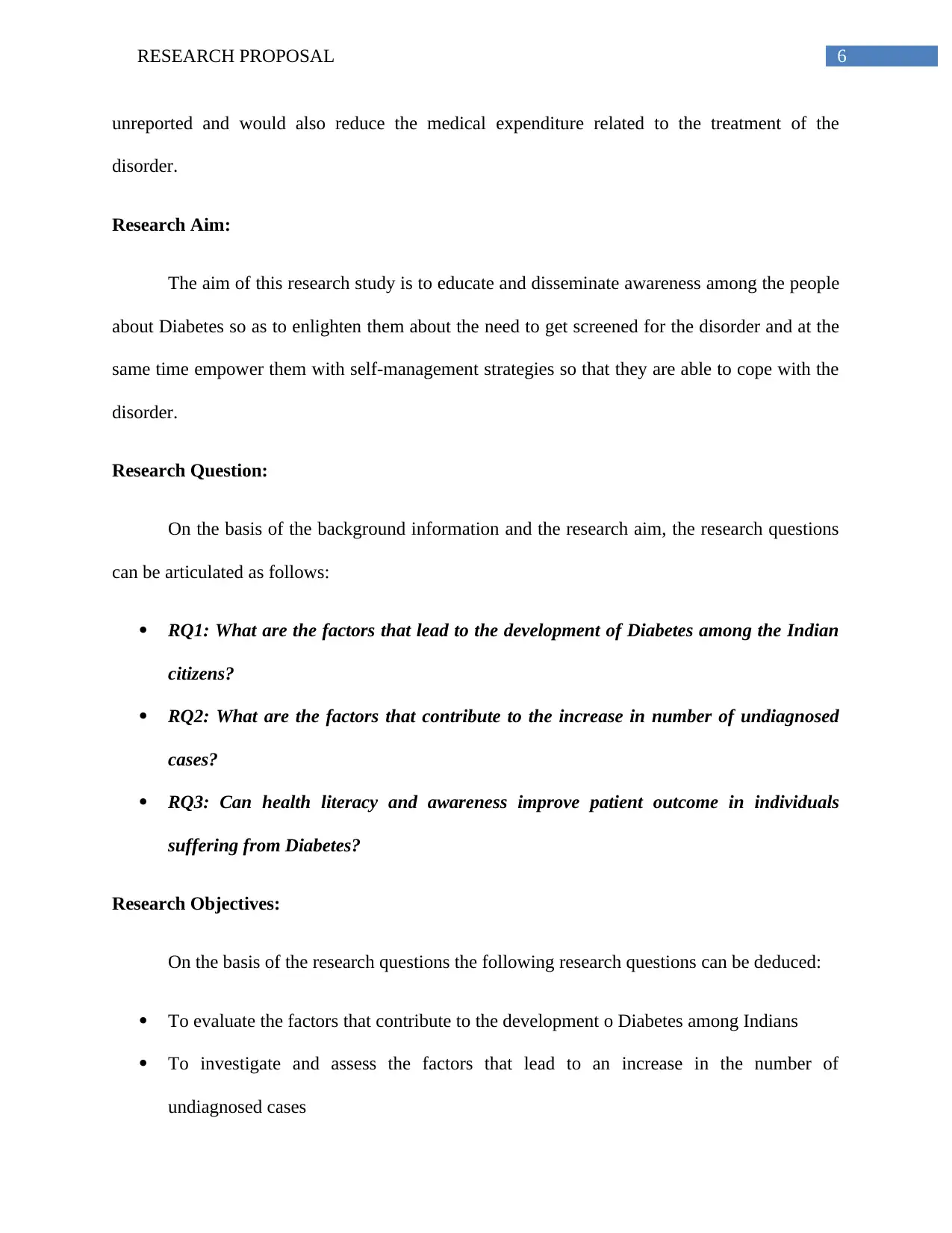
6RESEARCH PROPOSAL
unreported and would also reduce the medical expenditure related to the treatment of the
disorder.
Research Aim:
The aim of this research study is to educate and disseminate awareness among the people
about Diabetes so as to enlighten them about the need to get screened for the disorder and at the
same time empower them with self-management strategies so that they are able to cope with the
disorder.
Research Question:
On the basis of the background information and the research aim, the research questions
can be articulated as follows:
RQ1: What are the factors that lead to the development of Diabetes among the Indian
citizens?
RQ2: What are the factors that contribute to the increase in number of undiagnosed
cases?
RQ3: Can health literacy and awareness improve patient outcome in individuals
suffering from Diabetes?
Research Objectives:
On the basis of the research questions the following research questions can be deduced:
To evaluate the factors that contribute to the development o Diabetes among Indians
To investigate and assess the factors that lead to an increase in the number of
undiagnosed cases
unreported and would also reduce the medical expenditure related to the treatment of the
disorder.
Research Aim:
The aim of this research study is to educate and disseminate awareness among the people
about Diabetes so as to enlighten them about the need to get screened for the disorder and at the
same time empower them with self-management strategies so that they are able to cope with the
disorder.
Research Question:
On the basis of the background information and the research aim, the research questions
can be articulated as follows:
RQ1: What are the factors that lead to the development of Diabetes among the Indian
citizens?
RQ2: What are the factors that contribute to the increase in number of undiagnosed
cases?
RQ3: Can health literacy and awareness improve patient outcome in individuals
suffering from Diabetes?
Research Objectives:
On the basis of the research questions the following research questions can be deduced:
To evaluate the factors that contribute to the development o Diabetes among Indians
To investigate and assess the factors that lead to an increase in the number of
undiagnosed cases
Paraphrase This Document
Need a fresh take? Get an instant paraphrase of this document with our AI Paraphraser
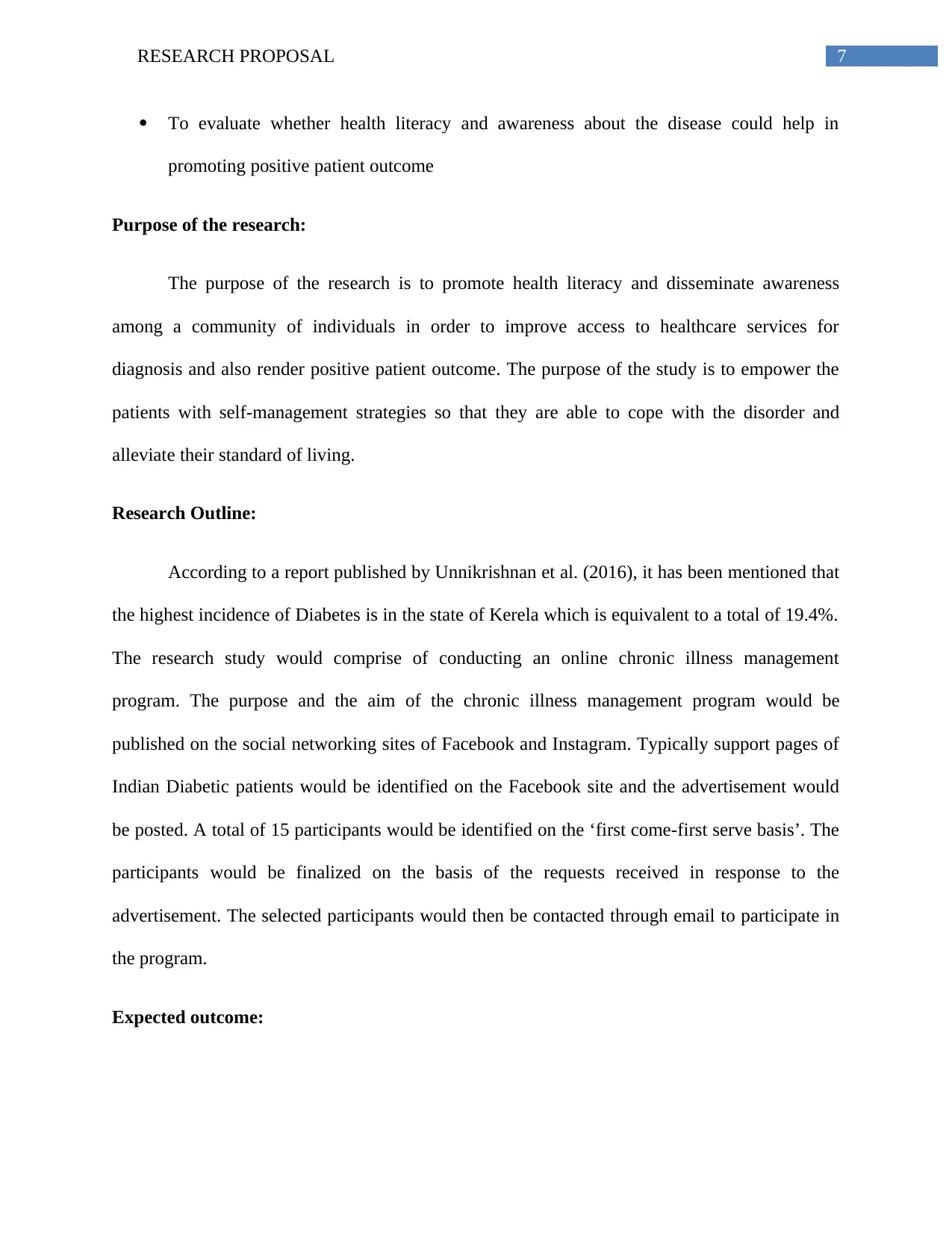
7RESEARCH PROPOSAL
To evaluate whether health literacy and awareness about the disease could help in
promoting positive patient outcome
Purpose of the research:
The purpose of the research is to promote health literacy and disseminate awareness
among a community of individuals in order to improve access to healthcare services for
diagnosis and also render positive patient outcome. The purpose of the study is to empower the
patients with self-management strategies so that they are able to cope with the disorder and
alleviate their standard of living.
Research Outline:
According to a report published by Unnikrishnan et al. (2016), it has been mentioned that
the highest incidence of Diabetes is in the state of Kerela which is equivalent to a total of 19.4%.
The research study would comprise of conducting an online chronic illness management
program. The purpose and the aim of the chronic illness management program would be
published on the social networking sites of Facebook and Instagram. Typically support pages of
Indian Diabetic patients would be identified on the Facebook site and the advertisement would
be posted. A total of 15 participants would be identified on the ‘first come-first serve basis’. The
participants would be finalized on the basis of the requests received in response to the
advertisement. The selected participants would then be contacted through email to participate in
the program.
Expected outcome:
To evaluate whether health literacy and awareness about the disease could help in
promoting positive patient outcome
Purpose of the research:
The purpose of the research is to promote health literacy and disseminate awareness
among a community of individuals in order to improve access to healthcare services for
diagnosis and also render positive patient outcome. The purpose of the study is to empower the
patients with self-management strategies so that they are able to cope with the disorder and
alleviate their standard of living.
Research Outline:
According to a report published by Unnikrishnan et al. (2016), it has been mentioned that
the highest incidence of Diabetes is in the state of Kerela which is equivalent to a total of 19.4%.
The research study would comprise of conducting an online chronic illness management
program. The purpose and the aim of the chronic illness management program would be
published on the social networking sites of Facebook and Instagram. Typically support pages of
Indian Diabetic patients would be identified on the Facebook site and the advertisement would
be posted. A total of 15 participants would be identified on the ‘first come-first serve basis’. The
participants would be finalized on the basis of the requests received in response to the
advertisement. The selected participants would then be contacted through email to participate in
the program.
Expected outcome:
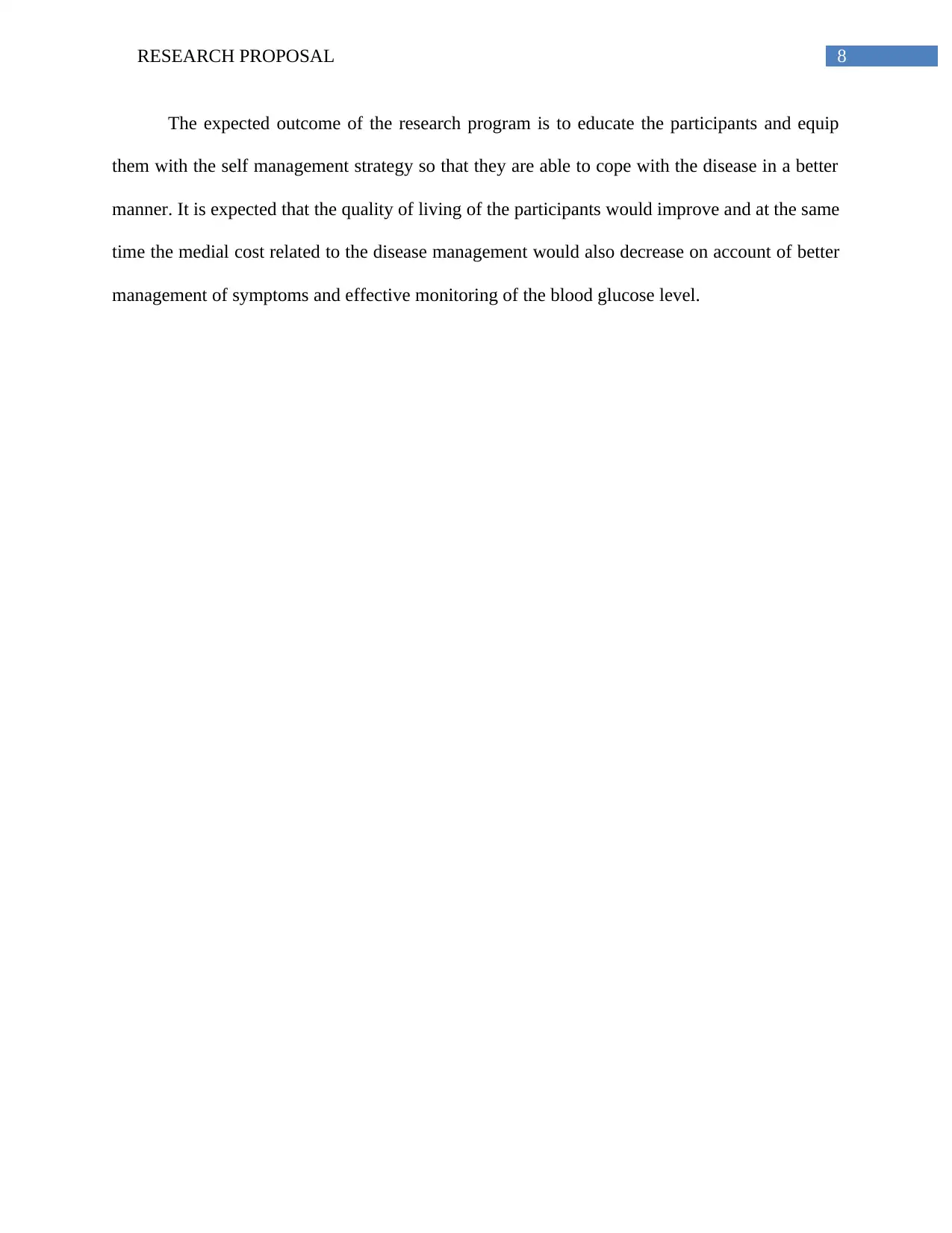
8RESEARCH PROPOSAL
The expected outcome of the research program is to educate the participants and equip
them with the self management strategy so that they are able to cope with the disease in a better
manner. It is expected that the quality of living of the participants would improve and at the same
time the medial cost related to the disease management would also decrease on account of better
management of symptoms and effective monitoring of the blood glucose level.
The expected outcome of the research program is to educate the participants and equip
them with the self management strategy so that they are able to cope with the disease in a better
manner. It is expected that the quality of living of the participants would improve and at the same
time the medial cost related to the disease management would also decrease on account of better
management of symptoms and effective monitoring of the blood glucose level.
⊘ This is a preview!⊘
Do you want full access?
Subscribe today to unlock all pages.

Trusted by 1+ million students worldwide
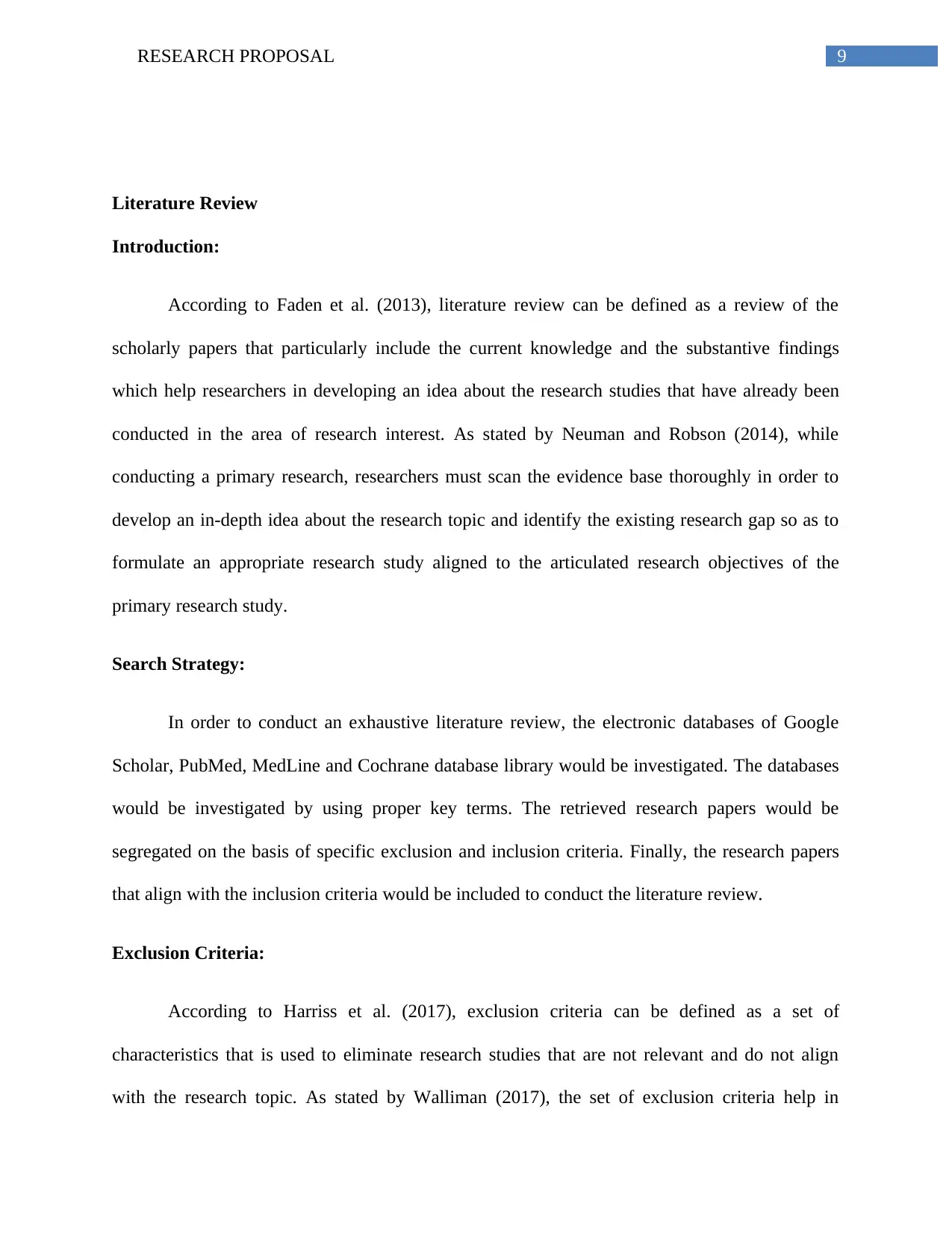
9RESEARCH PROPOSAL
Literature Review
Introduction:
According to Faden et al. (2013), literature review can be defined as a review of the
scholarly papers that particularly include the current knowledge and the substantive findings
which help researchers in developing an idea about the research studies that have already been
conducted in the area of research interest. As stated by Neuman and Robson (2014), while
conducting a primary research, researchers must scan the evidence base thoroughly in order to
develop an in-depth idea about the research topic and identify the existing research gap so as to
formulate an appropriate research study aligned to the articulated research objectives of the
primary research study.
Search Strategy:
In order to conduct an exhaustive literature review, the electronic databases of Google
Scholar, PubMed, MedLine and Cochrane database library would be investigated. The databases
would be investigated by using proper key terms. The retrieved research papers would be
segregated on the basis of specific exclusion and inclusion criteria. Finally, the research papers
that align with the inclusion criteria would be included to conduct the literature review.
Exclusion Criteria:
According to Harriss et al. (2017), exclusion criteria can be defined as a set of
characteristics that is used to eliminate research studies that are not relevant and do not align
with the research topic. As stated by Walliman (2017), the set of exclusion criteria help in
Literature Review
Introduction:
According to Faden et al. (2013), literature review can be defined as a review of the
scholarly papers that particularly include the current knowledge and the substantive findings
which help researchers in developing an idea about the research studies that have already been
conducted in the area of research interest. As stated by Neuman and Robson (2014), while
conducting a primary research, researchers must scan the evidence base thoroughly in order to
develop an in-depth idea about the research topic and identify the existing research gap so as to
formulate an appropriate research study aligned to the articulated research objectives of the
primary research study.
Search Strategy:
In order to conduct an exhaustive literature review, the electronic databases of Google
Scholar, PubMed, MedLine and Cochrane database library would be investigated. The databases
would be investigated by using proper key terms. The retrieved research papers would be
segregated on the basis of specific exclusion and inclusion criteria. Finally, the research papers
that align with the inclusion criteria would be included to conduct the literature review.
Exclusion Criteria:
According to Harriss et al. (2017), exclusion criteria can be defined as a set of
characteristics that is used to eliminate research studies that are not relevant and do not align
with the research topic. As stated by Walliman (2017), the set of exclusion criteria help in
Paraphrase This Document
Need a fresh take? Get an instant paraphrase of this document with our AI Paraphraser
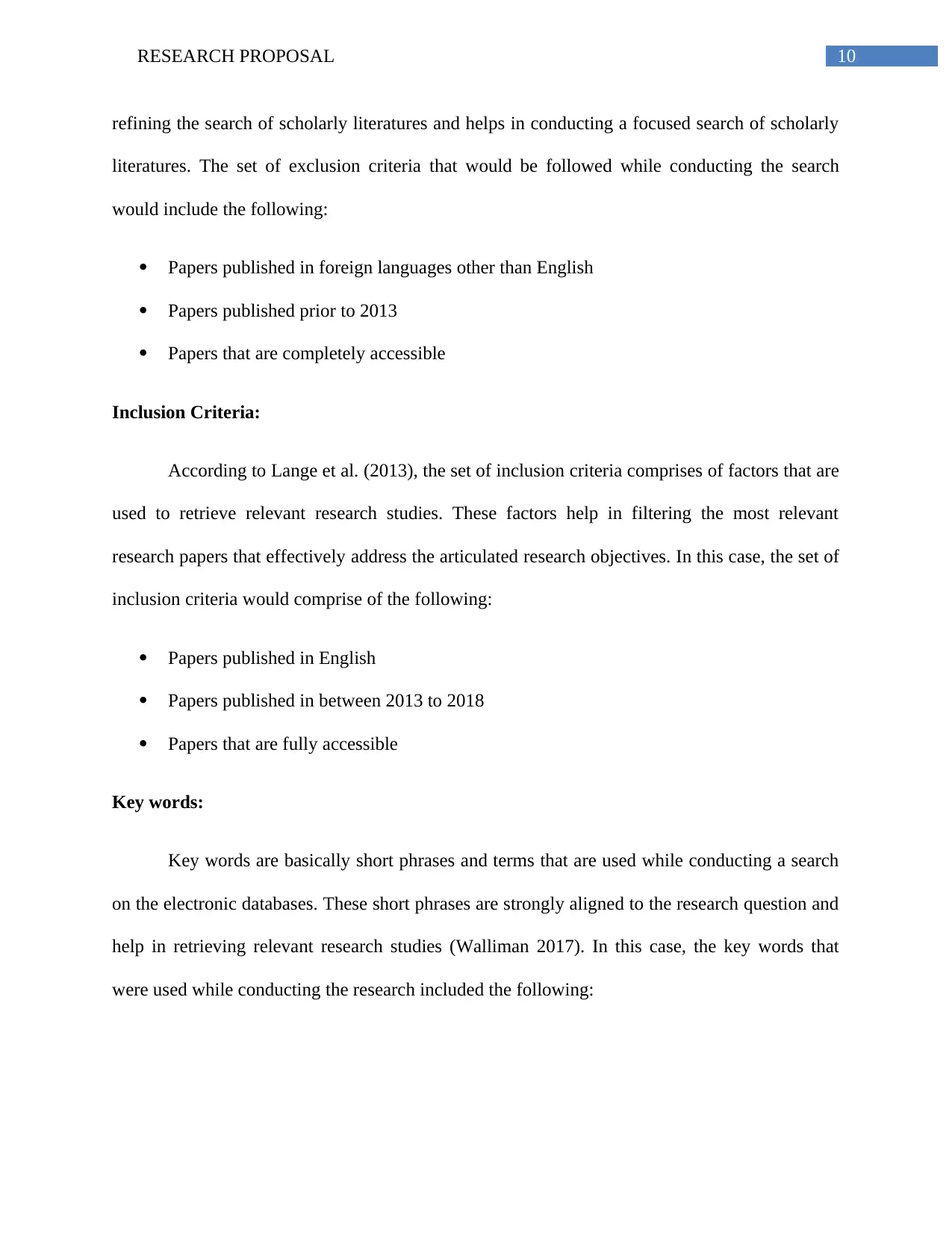
10RESEARCH PROPOSAL
refining the search of scholarly literatures and helps in conducting a focused search of scholarly
literatures. The set of exclusion criteria that would be followed while conducting the search
would include the following:
Papers published in foreign languages other than English
Papers published prior to 2013
Papers that are completely accessible
Inclusion Criteria:
According to Lange et al. (2013), the set of inclusion criteria comprises of factors that are
used to retrieve relevant research studies. These factors help in filtering the most relevant
research papers that effectively address the articulated research objectives. In this case, the set of
inclusion criteria would comprise of the following:
Papers published in English
Papers published in between 2013 to 2018
Papers that are fully accessible
Key words:
Key words are basically short phrases and terms that are used while conducting a search
on the electronic databases. These short phrases are strongly aligned to the research question and
help in retrieving relevant research studies (Walliman 2017). In this case, the key words that
were used while conducting the research included the following:
refining the search of scholarly literatures and helps in conducting a focused search of scholarly
literatures. The set of exclusion criteria that would be followed while conducting the search
would include the following:
Papers published in foreign languages other than English
Papers published prior to 2013
Papers that are completely accessible
Inclusion Criteria:
According to Lange et al. (2013), the set of inclusion criteria comprises of factors that are
used to retrieve relevant research studies. These factors help in filtering the most relevant
research papers that effectively address the articulated research objectives. In this case, the set of
inclusion criteria would comprise of the following:
Papers published in English
Papers published in between 2013 to 2018
Papers that are fully accessible
Key words:
Key words are basically short phrases and terms that are used while conducting a search
on the electronic databases. These short phrases are strongly aligned to the research question and
help in retrieving relevant research studies (Walliman 2017). In this case, the key words that
were used while conducting the research included the following:
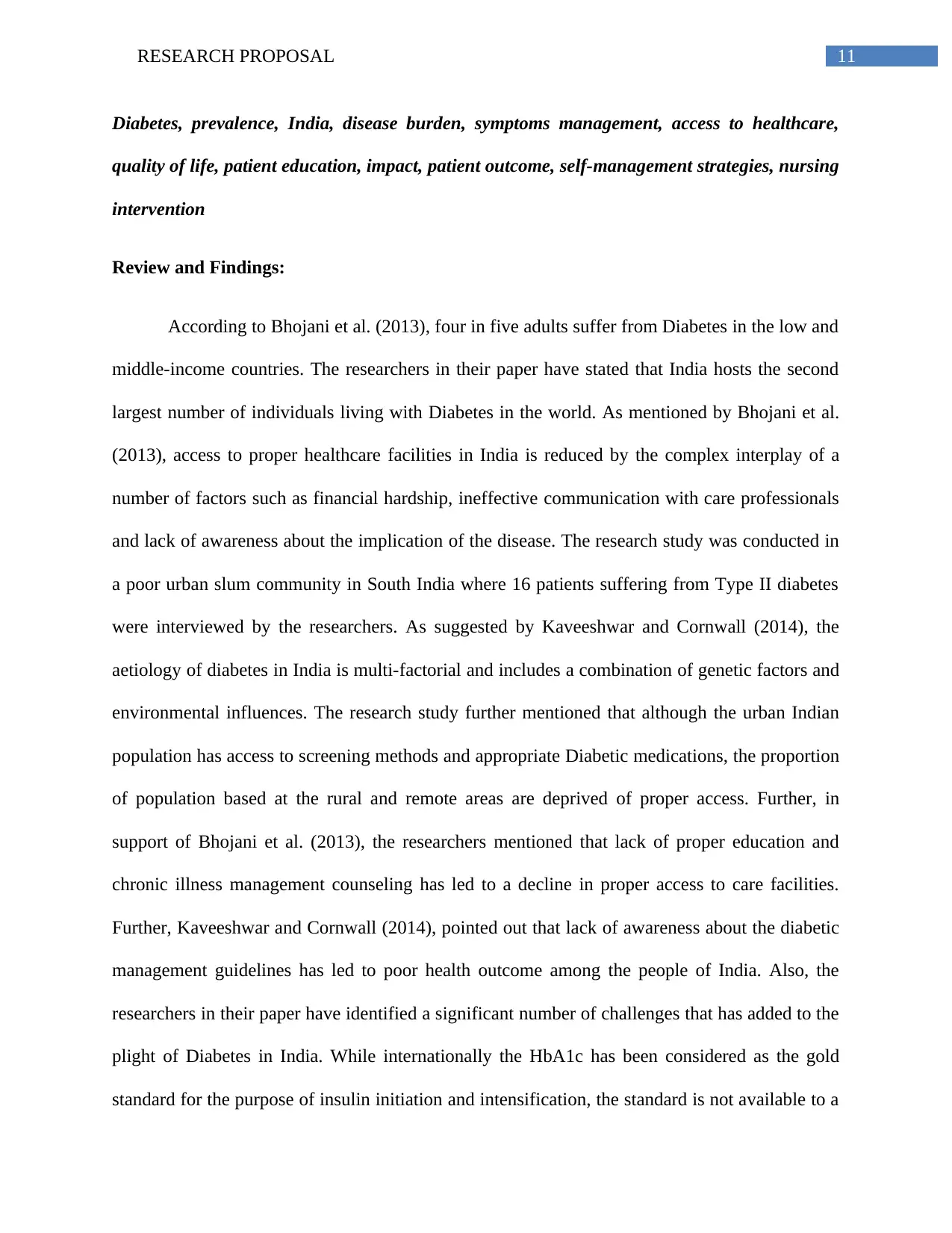
11RESEARCH PROPOSAL
Diabetes, prevalence, India, disease burden, symptoms management, access to healthcare,
quality of life, patient education, impact, patient outcome, self-management strategies, nursing
intervention
Review and Findings:
According to Bhojani et al. (2013), four in five adults suffer from Diabetes in the low and
middle-income countries. The researchers in their paper have stated that India hosts the second
largest number of individuals living with Diabetes in the world. As mentioned by Bhojani et al.
(2013), access to proper healthcare facilities in India is reduced by the complex interplay of a
number of factors such as financial hardship, ineffective communication with care professionals
and lack of awareness about the implication of the disease. The research study was conducted in
a poor urban slum community in South India where 16 patients suffering from Type II diabetes
were interviewed by the researchers. As suggested by Kaveeshwar and Cornwall (2014), the
aetiology of diabetes in India is multi-factorial and includes a combination of genetic factors and
environmental influences. The research study further mentioned that although the urban Indian
population has access to screening methods and appropriate Diabetic medications, the proportion
of population based at the rural and remote areas are deprived of proper access. Further, in
support of Bhojani et al. (2013), the researchers mentioned that lack of proper education and
chronic illness management counseling has led to a decline in proper access to care facilities.
Further, Kaveeshwar and Cornwall (2014), pointed out that lack of awareness about the diabetic
management guidelines has led to poor health outcome among the people of India. Also, the
researchers in their paper have identified a significant number of challenges that has added to the
plight of Diabetes in India. While internationally the HbA1c has been considered as the gold
standard for the purpose of insulin initiation and intensification, the standard is not available to a
Diabetes, prevalence, India, disease burden, symptoms management, access to healthcare,
quality of life, patient education, impact, patient outcome, self-management strategies, nursing
intervention
Review and Findings:
According to Bhojani et al. (2013), four in five adults suffer from Diabetes in the low and
middle-income countries. The researchers in their paper have stated that India hosts the second
largest number of individuals living with Diabetes in the world. As mentioned by Bhojani et al.
(2013), access to proper healthcare facilities in India is reduced by the complex interplay of a
number of factors such as financial hardship, ineffective communication with care professionals
and lack of awareness about the implication of the disease. The research study was conducted in
a poor urban slum community in South India where 16 patients suffering from Type II diabetes
were interviewed by the researchers. As suggested by Kaveeshwar and Cornwall (2014), the
aetiology of diabetes in India is multi-factorial and includes a combination of genetic factors and
environmental influences. The research study further mentioned that although the urban Indian
population has access to screening methods and appropriate Diabetic medications, the proportion
of population based at the rural and remote areas are deprived of proper access. Further, in
support of Bhojani et al. (2013), the researchers mentioned that lack of proper education and
chronic illness management counseling has led to a decline in proper access to care facilities.
Further, Kaveeshwar and Cornwall (2014), pointed out that lack of awareness about the diabetic
management guidelines has led to poor health outcome among the people of India. Also, the
researchers in their paper have identified a significant number of challenges that has added to the
plight of Diabetes in India. While internationally the HbA1c has been considered as the gold
standard for the purpose of insulin initiation and intensification, the standard is not available to a
⊘ This is a preview!⊘
Do you want full access?
Subscribe today to unlock all pages.

Trusted by 1+ million students worldwide
1 out of 25
Related Documents
Your All-in-One AI-Powered Toolkit for Academic Success.
+13062052269
info@desklib.com
Available 24*7 on WhatsApp / Email
![[object Object]](/_next/static/media/star-bottom.7253800d.svg)
Unlock your academic potential
Copyright © 2020–2025 A2Z Services. All Rights Reserved. Developed and managed by ZUCOL.





